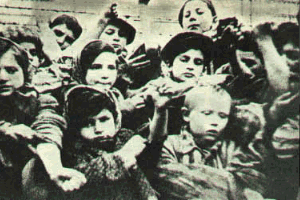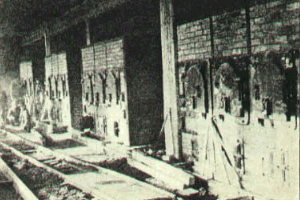
> Introduction <
[Timeline]
[Maps]
[Glossary]
AUSCHWITZ / BIRKENAU CONCENTRATION CAMP IN
OSWIECIM, POLAND - INTRODUCTION
All over the world, Auschwitz has become a symbol of terror, genocide, and the Holocaust. It was established by the Nazis in 1940, in the suburbs of the city of Oswiecim which, like other parts of Poland, was occupied by the Germans during the Second World War. The name of the city of Oswiecim was changed to Auschwitz, which became the name of the camp as well.
Over the following years, the camp was expanded and consisted of three main parts: Auschwitz I, Auschwitz II-Birkenau, and Auschwitz III-Monowitz. It also had over 40 sub-camps. At first, Poles were imprisoned and died in the camp. Afterwards, Soviet prisoners of war, Gypsies, and prisoners of other nationalities were also incarcerated there. Beginning in 1942, the camp became the site of the greatest mass murder in the history of humanity, which was committed against the European Jews as part of Hitler's plan for the complete destruction of that people. The majority of the Jewish men, women and children deported to Auschwitz were sent to their deaths in the Birkenau gas chambers immediately after arrival. At the end of the war, in an effort to remove the traces of the crimes they had committed, the SS began dismantling and razing the gas chambers, crematoria, and other buildings, as well as burning documents.


From left: Children of Auschwitz; Crematoria of Auschwitz
Prisoners capable of marching were evacuated into the depths of the Reich. Those who remained behind in the camp were liberated by Red Army soldiers on January 27, 1945. A July 2, 1947 act of the Polish parliament established the Auschwitz-Birkenau State Museum on the grounds of the two extant parts of the camp, Auschwitz I and Auschwitz II-Birkenau. The site was added to the UNESCO World Heritage List in 1979.
The Auschwitz complex was the site of scientifically planned and efficiently executed genocide during World War II. Accurate statistics were not kept, but the estimates of deaths at the camp complex range from 1.5 million to as many as 4 million. Camp Commandant Rudolf Hoess admitted to a minimum figure of 2.5 million deaths at Auschwitz. Reflecting back some years later on the experiments in the basement of Block 11 and later in Gas Chamber and Crematorium 1, Hoess said:
"At the time I did not think about the problem of killing Soviet prisoners of war. It was an order and I had to execute it. However, I will say frankly that killing that group of people by gas relieved my anxieties. It would soon be necessary to start the mass extermination of the Jews, and until that moment neither I Eichmann had known how to conduct a mass killing. A sort of gas was to be used, but it was not known what kind of gas was meant and how to use it. Now we had both the gas and the way of using it. I had always been concerned at the thought of mass shootings, particularly of women and children. I was already sick of executions. Now my mind was at ease."
Jews comprised the largest number of victims, and Auschwitz has become the prime symbol of what became known as the Holocaust of European Jewry; at least one-third of the estimated 5 million to 6 million Jews killed by the Nazis during World War II died there. Large numbers of Poles, Soviet prisoners of war, gypsies, and homosexuals also died at Auschwitz.
The Nazis established Auschwitz in April 1940 under the direction of Heinrich Himmler, chief of two Nazi organizations-the Nazi guards known as the Schutzstaffel (SS), and the secret police known as the Gestapo. The camp at Auschwitz originally housed political prisoners from occupied Poland and from concentration camps within Germany. Construction of nearby Birkenau (Brzezinka), also known as Auschwitz II, began in October 1941 and included a women's section after August 1942. Birkenau had four gas chambers, designed to resemble showers, and four crematoria, used to incinerate bodies.
Approximately 40 more satellite camps were established around Auschwitz. These were forced labor camps and were known collectively as Auschwitz III. The first one was built at Monowitz and held Poles who had been forcibly evacuated from their hometowns by the Nazis. Prisoners were transported from all over Nazi-occupied Europe by rail, arriving at Auschwitz in daily convoys. Arrivals at the complex were separated into three groups. One group went to the gas chambers within a few hours; these people were sent to the Birkenau camp, where more than 20,000 people could be gassed and cremated each day. At Birkenau, the Nazis used a cyanide gas called Zyklon-B, which was manufactured by a pest-control company. A second group of prisoners were used as slave labor at industrial factories for such companies as I. G. Farben and Krupp.
At the Auschwitz complex 405,000 prisoners were recorded as laborers between 1940 and 1945. Of these about 340,000 perished through executions, beatings, starvation, and sickness. Some prisoners survived through the help of German industrialist Oskar Schindler, who saved about 1000 Polish Jews by diverting them from Auschwitz to work for him, first in his factory near Krakow and later at a factory in what is now the Czech Republic. A third group, mostly twins and dwarfs, underwent medical experiments at the hands of doctors such as Josef Mengele, who was also known as the "Angel of Death." The camp was staffed partly by prisoners, some of whom were selected to be kapos (orderlies) and sonderkommandos (workers at the crematoria).




From left:
Entrance to Auschwitz I "Arbeit Macht Frei" (Work Makes One
Free);
View of the execution wall next to Block 11 in the Auschwitz I camp;
Hungarian Jews after intake procedure; Piles of shoes of murdered
prisoners.
Members of these groups were killed periodically. The kapos and sonderkommandos were supervised by members of the SS; altogether 6000 SS members worked at Auschwitz. By 1943 resistance organizations had developed in the camp. These organizations helped a few prisoners escape; these escapees took with them news of exterminations, such as the killing of hundreds of thousands of Jews transported from Hungary between May and July 1944. In October 1944 a group of sonderkommandos destroyed one of the gas chambers at Birkenau. They and their accomplices, a group of women from the Monowitz labor camp, were all put to death. When the Soviet army marched into Auschwitz to liberate the camp on January 27, 1945, they found about 7600 survivors abandoned there. More than 58,000 prisoners had already been evacuated by the Nazis and sent on a final death march to Germany. In 1946 Poland founded a museum at the site of the Auschwitz concentration camp in remembrance of its victims. By 1994, about 22 million visitors-700,000 annually-had passed through the iron gates that bear the cynical motto Arbeit macht frei (work makes one free).
German war interests required the maximization of economic benefits from this cold-blooded murder. Before the bodies were burned the victim's hair was cut off and fillings and false teeth made of precious metals were removed. The hair was used for making haircloth, and the metals were melted into bars and sent to Berlin. After the liberation tons of hair were found in camp warehouses; the Nazis had not had time to process it all. Proof that this hair came from victims of gassing was provided by The
Cracow Institute of Judicial Expertise, whose analyses showed that traces of prussic acid, a poisonous component typical of Zyklon compounds, were present in the hair.
In 1941-1944 prisoner of KL Auschwitz, then of KL Gross-Rosen and KL Flossenburg-Leitmeritz, from which he escaped in April 1945. After the war, journalist, author of many articles about Auschwitz: active in many associations and organizations, acting, for example as Secretary General of the International Auschwitz Committee and member of the Main Commission for the investigation of Nazi Crimes in Poland.
Deniers acknowledge that some Jews were incarcerated in places such as Auschwitz, but they maintain, as they did at the trial of a Holocaust denier in Canada, it was equipped with "all the luxuries of a country club, including a swimming pool, a dance hall and recreational facilities." Some Jews may have died, they said, but this was the natural consequence of wartime deprivations."
AUSCHWITZ SITE MENU
Introduction
|
History &
Facts |
Timeline |
Auschwitz &
Birkenau Photography
|
Experiments
|
Survivors
|
Maps
|
Glossary
|
Visiting
Auschwitz |
Organizations
| Auschwitz
Travel Info |
Warsaw
City Guide |
Krakow City Guide |
Advertise Here |
Contact
Us |
LukeTravels.com Home
Page
![]()
|
|
|
|
|
|
|
|